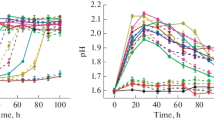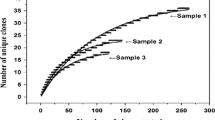Abstract
The influence of different concentrations of copper solvent extractant ZJ 988 on the growth and activity of acidophilic microorganisms was studied and the microbial community structures were compared by 16S rRNA gene clone library analysis. The total bacteria numbers are reduced when 0.5% (volume fraction) extractant is added. The proportions of Acidithiobacillus ferrooxidans and Acidiphilium organovorum are increased, whereas the proportion of Leptospirillum ferriphilum is reduced. When the concentration of extractant is elevated to 1%, growth of all bacteria is inhibited. Clone library results reveal that the dominant bacteria in the culture solution with/without the extractant are At. ferrooxidans, A. organovorum and L. ferriphilum. The sensitivity order of the three bacteria to the extractant from the most to the least is found to be L. ferriphilum>At. ferrooxidans>A. organovorum.
Similar content being viewed by others
References
BRIERLEY J A, BRIERLEY C L. Present and future commercial applications of biohydrometallurgy [J]. Hydrometallurgy, 2001, 59(2/3): 233–239.
TRIBUTSCH H. Direct versus indirect bioleaching [J]. Hydrometallurgy, 2001, 59(2/3): 177–185.
RUAN Ren-man, WEN Jian-kang, CHEN Jing-he. Bacterial heap-leaching: Practice in Zijinshan copper mine [J]. Hydrometallurgy, 2006, 83(1/4): 77–82.
RAWLINGS D E, DEW D, CHRIS D. Biomineralization of metal-containing ores and concentrates [J]. Trends in Biotechnology, 2003, 21(1): 38–44.
TORMA A E, ITZKOVITCH I J. Influence of organic solvents on chalcopyrite oxidation ability of Thiobacillus ferrooxidans [J]. Applied and Environmental Microbiology, 1976, 32(1): 102–107.
MAZUELOS A, IGLESIAS N, CARRANZA F. Inhibition of bioleaching processes by organics from solvent extraction [J]. Process Biochemistry, 1999, 35(5): 425–431.
OKIBE N, JOHNSON D B. Toxicity of flotation reagents to moderately thermophilic bioleaching microorganisms [J]. Biotechnology Letters, 2002, 24(23): 2011–2016.
ASTON J E, APEL W A, LEE B D, PEYTON B M. Toxicity of select organic acids to the slightly thermophilic acidophile Acidithiobacillus caldus [J]. Environmental Toxicology and Chemistry, 2009, 28(2): 279–286.
QIU Guan-zhou, LIU Xiao-rong, HU Yue-hua. The effects of organic phases in solvent extraction on bioleaching bacteria [J]. Journal of Central South University of Technology: Natural Science, 2001, 32(3): 243–246. (in Chinese)
WATLING H R, PERROT F A, SHIERS D W, GROSHEVA A, RICHARDS T N. Impact of the copper solvent extraction reagent LIX 984N on the growth and activity of selected acidophiles [J]. Hydrometallurgy, 2009, 95(3/4): 302–307.
OVED T, SHAVIV A, GOLDRATH T, MANDELBAUM R T, MINZ D. Influence of effluent irrigation on community composition and function of ammonia-oxidizing bacteria in soil [J]. Applied and Environmental Microbiology, 2001, 67(8): 3426–3433.
WEISBURG W G, BARNS S M, PELLETIER D A, LANE D J. 16S ribosomal DNA amplification for phylogenetic study [J]. Journal of Bacteriology, 1991, 173(2): 697–703.
THOMPSON J D, GIBSON T J, PLEWNIAK F. The ClustalX windows interface: Flexible strategies for multiple sequence alignment aided by quality analysis tools [J]. Nucleic Acids Research, 1997, 24: 4876–4882.
SCHLOSS P D, HANDELSMAN J. Introducing DOTUR, a computer program for defining operational taxonomic units and estimating species richness [J]. Applied and Environmental Microbiology, 2005, 71(3): 1501–1506.
CHAO A, SHEN T J. Program SPADE (Species Prediction and Diversity Estimation) [EB/OL]. [2009-02-13]. http://chao.stat.nthu.edu.tw.
TAMURA K, DUDLEY J, NEI M, KUMAR S. MEGA4: Molecular evolutionary genetics analysis (MEGA) software version 4.0 [J]. Molecular Biology and Evolution, 2007, 24: 1596–1599.
CORAM N J, RAWLINGS D E. Molecular relationship between two groups of the genus Leptospirillum and the finding that Leptospirillum ferriphilum sp. nov. dominates South African commercial biooxidation tanks that operate at 40 °C [J]. Applied and Environmental Microbiology, 2002, 68(2): 838–845.
RAWLINGS D E. Biomining: Theory, microbes and industrial processes [M]. New York: Springer, 1997: 229–245.
FOWLER T A, HOLMES P R, CRUNDWELL F K. Mechanism of pyrite dissolution in the presence of Thiobacillus ferrooxidans [J]. Applied and Environmental Microbiology, 1999, 65(7): 2987–2993.
FRATTINI C J, LEDUC L G, FERRONI G D. Strain variability and the effects of organic compounds on the growth of the chemolithotrophic bacterium Thiobacillus ferrooxidans [J]. Antonie van Leeuwenhoek, 2000, 77(1): 57–64.
LOBOS J H, CHISOLM T E, BOPP L H, HOLMES D S. Acidiphilium organovorum sp. nov., an acidophilic heterotroph culture isolated from a Thiobacillus ferrooxidans [J]. International Journal of Systematic Bacteriology, 1986, 36(2): 139–144.
COUPLAND K, JOHNSON D B. Evidence that the potential for dissimilatory ferric iron reduction is wide spread among acidophilic heterotrophic bacteria [J]. FEMS Microbiology Letters, 2008, 279: 30–35.
Author information
Authors and Affiliations
Corresponding author
Additional information
Foundation item: Project(50904011) supported by the National Natural Science Foundation of China
Rights and permissions
About this article
Cite this article
Chen, Bw., Li, Wj., Liu, Xy. et al. Influence of copper solvent extractant on microbial community structure of acidophilic microorganisms. J. Cent. South Univ. Technol. 17, 1196–1200 (2010). https://doi.org/10.1007/s11771-010-0618-x
Received:
Accepted:
Published:
Issue Date:
DOI: https://doi.org/10.1007/s11771-010-0618-x




